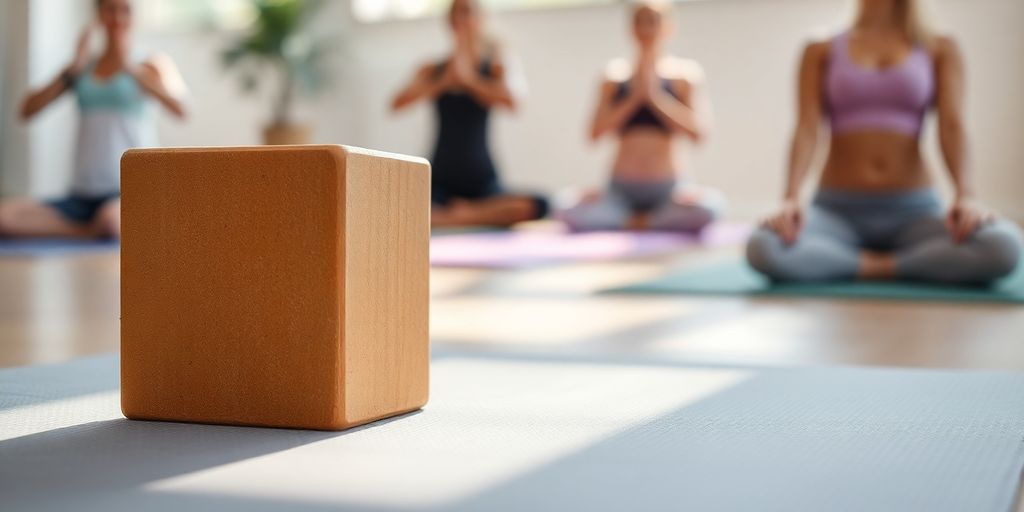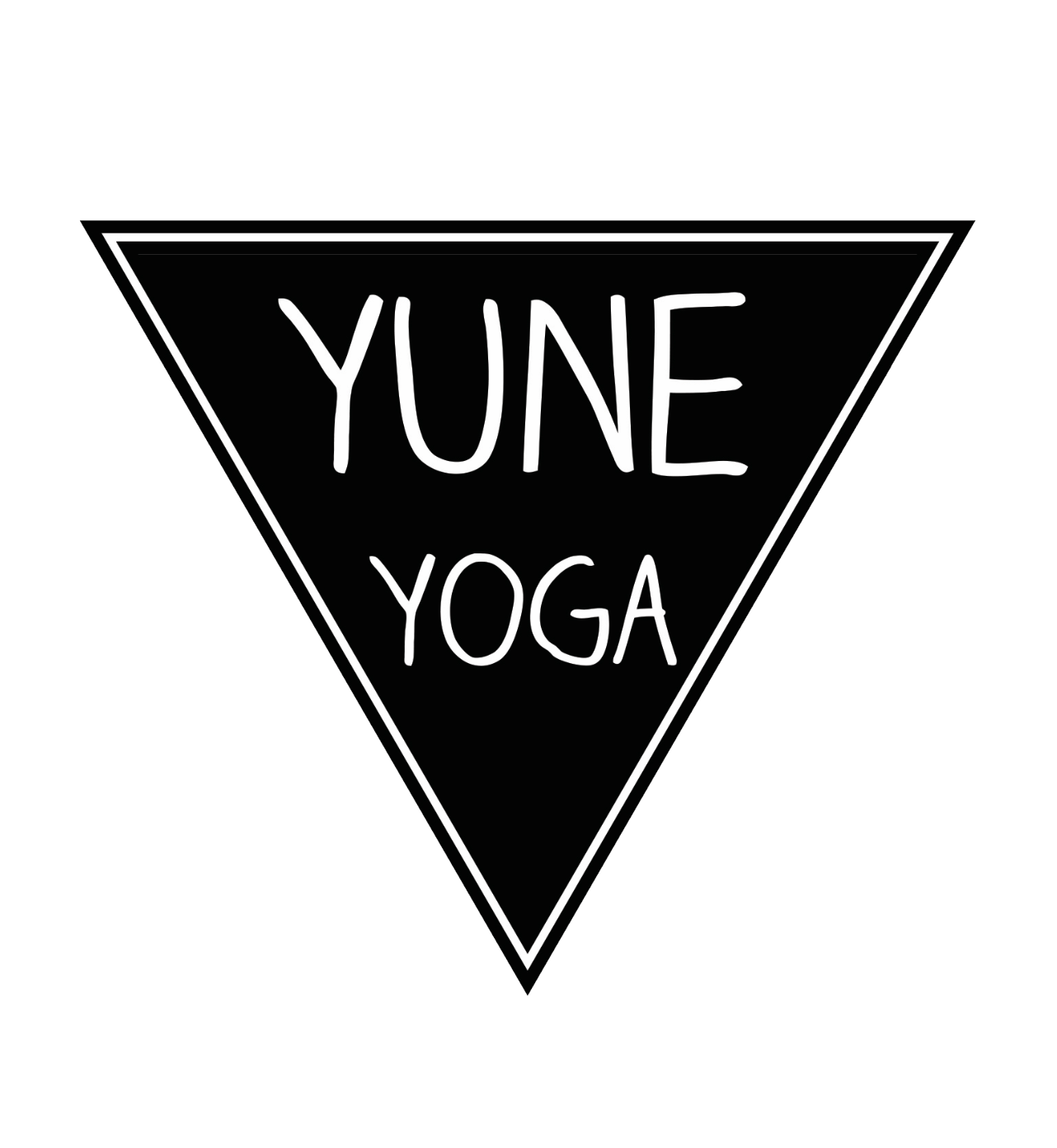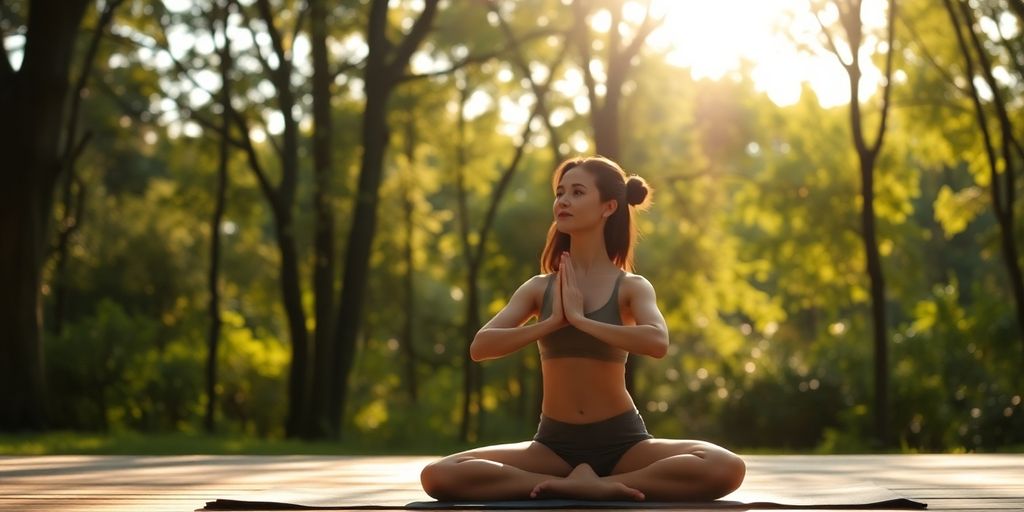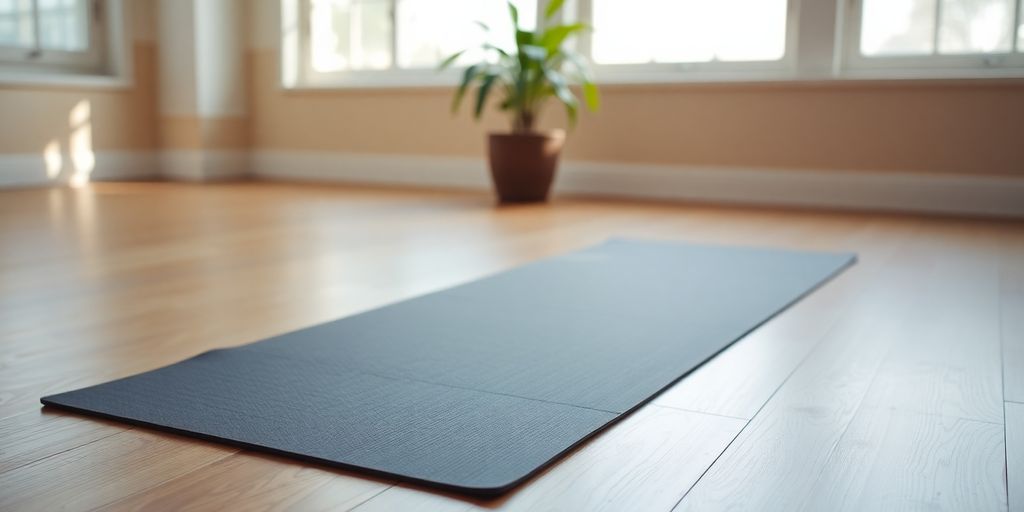
What is a Yoga Block? Understanding Its Purpose and Benefits in Your Practice
Yoga blocks are versatile props that can significantly enhance your yoga practice, whether you're a beginner or a seasoned pro. These simple tools can help you achieve better alignment, increase your flexibility, and provide support in challenging poses. Understanding what a yoga block is and how to use it can transform the way you experience yoga, making it more accessible and enjoyable.
Key Takeaways
- Yoga blocks help make poses more accessible for everyone.
- They provide support and stability, reducing the risk of injury.
- Using blocks can improve your posture alignment during practice.
- Yoga blocks enhance flexibility and strength by allowing deeper stretches.
- They are available in various materials and sizes to suit different needs.
What Is A Yoga Block?
Definition and Description
A yoga block is a small, rectangular tool that people use during yoga practice. It acts as a helper for either easing into a pose or adding a bit more of a challenge. This simple tool can make a huge difference in getting your body in the right position. You might find yoga block info mentioned as a popular accessory among many practitioners.
Materials and Sizes
Yoga blocks come in various materials and dimensions. Here’s a short table that shows a few common ones:
| Material | Common Dimensions (inches) | Notes |
|---|---|---|
| Foam | 9 x 6 x 4 | Soft and light |
| Cork | 9 x 6 x 4 | Hard and eco-friendly |
| Wood | 9 x 6 x 4 | Dense and durable |
These measurements are typical but can vary slightly. The materials change the block’s feel and weight.
Common Uses
Yoga blocks have a range of everyday uses in practice:
- They help you reach the floor or align your body more comfortably.
- They provide extra support during stretches and balance poses.
- They serve as a stepping guide to maintain proper form.
Blocks can be used both to support a beginner and to introduce a slight twist to more advanced moves. Enjoy exploring how one block can open up many options during your session.
What Are Yoga Blocks Used For?
Yoga blocks serve many practical roles in your workout, making them useful in a variety of poses. They help bridge gaps in flexibility and ensure you can work safely and confidently, even on those tricky moves.
Extending Reach in Poses
Trying to touch the floor or extend your arms fully in a challenging pose can be frustrating. A yoga block placed strategically gives you that extra bit of height and reach, turning a nearly impossible stretch into something more doable. This little prop turns a struggle into a manageable step in your routine.
Below is a simple comparison of your reach with and without a block:
| Scenario | Reach Capability | Ease of Poses |
|---|---|---|
| Without Block | Limited | More Difficult |
| With Block | Extended | Much Simpler |
Providing Support and Stability
Yoga blocks also act as a firm support when your balance is off or the pose demands extra stability. They are especially handy when you need a secure base to rest your arms or back, helping your body maintain a proper line. Consider these key points:
- They add extra height to ease tension in extended poses.
- They offer a stable guide when alignment is off.
- They help you feel supported, reducing the chance of strain.
Using a block as a support can feel like having another pair of hands in your practice, similar to a yoga mobility support that keeps you grounded.
Facilitating Safe Practice
Experimenting with new asanas can be intimidating. Blocks let you explore different positions without putting too much pressure on your body. They lighten the risk of overreaching and give you the freedom to try and adjust poses gradually.
Taking it slow and steady with the aid of a block can turn a daunting pose into a safe, enjoyable exploration of your limits.
Overall, using a yoga block can be a game changer, whether you're trying to extend your reach, gain more support, or simply practice without fear of injury. Each step with a block builds confidence and makes your yoga routine more accessible.
What Are The Benefits Of Yoga Blocks?
Yoga blocks aren’t just about adding an extra prop to your practice. They serve to make your poses feel more stable and comfortable. Using a block can change how your body experiences yoga, and sometimes even let you go a bit further than before.
Improving Posture Alignment
Using a yoga block can help keep your form right where it needs to be. When you place a block under your hand or foot, it gives your body a little boost to correct misalignment without straining muscles. A straight posture can really reduce the risk of unwanted strains.
- Helps adjust body angles
- Reduces pressure on joints
- Gives clear visual feedback on alignment
This extra support acts almost like a friendly reminder for your body to stay in line. It’s a simple tool that makes each pose safer.
Enhancing Flexibility and Strength
Blocks aren’t only there for safety. They can be a handy tool to gently increase your stretch and build strength at the same time. Even in cases where a pose seems a bit out of reach, the block makes it more accessible. In fact, here’s a simple table to show how a block might be used in a few common ways:
| Benefit | How It Works |
|---|---|
| Increased Reach | Extends the distance in difficult poses |
| Muscle Engagement | Challenges muscles in a controlled way |
| Gradual Stretch | Supports a deeper stretch without strain |
Each use not only helps you stretch but also trains your muscles to work better overall. It’s like slowly building up strength at your own pace.
Supporting Beginners and Injured Practitioners
For those just starting out or dealing with injuries, yoga blocks can be a real game changer. The added support lets you try new poses without worrying about pushing your limits too far. This is especially helpful when your body feels unsure about getting into the full posture.
- Offers a safe stepping stone for learning poses
- Lightens the load on problematic areas
- Gives confidence to try challenging movements
When you’re easing into yoga, using props like these can make the journey feel less intimidating and more fun. It’s a practical way to slowly build up your ability while keeping things safe.
Don't forget to check on security measures to ensure your yoga practice gear and online tools work just as safely as your mats and blocks.
Why Are Yoga Blocks Essential For Your Practice?

Yoga blocks open up more options during your yoga sessions by giving you extra support and stability. They can turn a tough pose into a manageable one, letting your body work safely at its own pace.
Creating Accessibility in Poses
Using a block can make poses more reachable. If you struggle to get your hands or feet into proper position, a block helps by lifting you just enough off the mat. This small change can add up to big differences during a session. Here are a few ways blocks help with accessibility:
- Raise your hands for better reach.
- Cushion your weight in poses like forward folds.
- Offer extra support during balancing poses.
Sometimes, having the right support feels like having a little extra boost.
Encouraging Proper Alignment
Blocks help keep your posture in check. When you use them, you can better align your body and avoid overreaching or leaning too far. This leads to poses that are safer and more comfortable. Consider this simple table:
| Benefit | Without Block | With Block |
|---|---|---|
| Posture Support | Low | High |
| Balance Control | Medium | High |
| Comfort Level | Low | High |
Using a block can guide your body to match the expected form, which minimizes strain on your joints. By adding blocks, you'll notice a big improvement in your routine.
Deepening Your Practice
A more confident practice comes with reliable props. Blocks help not only new practitioners but also those looking to refine advanced poses. They let you try variations safely and slowly build strength. You might also consider investing in premium yoga blocks to expand your range of practice.
Investing time to experiment with block-assisted poses often pays off. It means moving at a pace that respects your body and still explores new challenges.
When you mix creativity with consistency, yoga becomes a playground—even if it starts with something as simple as a block.
Types Of Yoga Blocks
Yoga blocks come in different materials, each with its own feel and benefits. Let’s break them down.
Foam Yoga Blocks
Foam blocks are light and easy to handle. They have a soft texture that makes them a good choice for everyday practice, especially if you are just starting out. You might choose foam blocks for these reasons:
- Lightweight and portable
- Affordable option for daily practice
- Gentle cushioning to ease into poses
Foam blocks are a popular pick for many beginners. They also help add extra reach safely. For a different take on these props, check out Yoga bricks.
Cork Yoga Blocks
Cork blocks offer a firmer feel and a more natural look. They work well if you need a bit more stability during your routine. Here’s why cork might work for you:
- Durable, so they hold up over time
- Environmentally friendly material
- Offers a balance between support and slight give
When you’re looking for a block that feels a bit sturdier, cork is a solid contender.
Wooden Yoga Blocks
Wooden blocks are known for their hard surface and long-lasting design. They give a solid base for challenging postures. Some benefits of wooden blocks include:
- Strong and steady support
- Excellent for deeper stretches
- Adds a traditional feel to your practice
Remember, the choice of block affects your comfort and performance. Opt for the one that suits your practice style best.
Here’s a quick comparison table for a clearer picture:
| Material | Approx. Weight | Firmness Level |
|---|---|---|
| Foam | Light | Soft |
| Cork | Medium | Firm |
| Wood | Heavy | Hard |
Each type brings a unique touch to your practice. Experiment with them and see which one feels right for you.
Incorporating Yoga Blocks Into Your Routine

Yoga blocks can change how you move in your practice. They help you feel safe and build confidence as you work through poses. Check out shop info for more background details on using these tools effectively.
Tips for Beginners
If you're just starting out, keep these ideas in mind:
- Place your block where you need a bit of extra reach.
- Move at your own pace, exploring the block's support in basic poses.
- Experiment with different placements, like under your hand or foot.
These small changes can make a big difference in your daily practice.
Begin by adding a block into your routine when you practice poses that feel a bit too challenging. Over time, as you get comfortable, you might notice improved balance and a more relaxed way of moving.
Advanced Techniques
For those looking to push a bit further, advanced techniques involve using blocks in less common ways. Here are a few methods that add variety to your session:
- Stacking blocks: This can modify the height of the support for deeper stretches.
- Shifting positions: Try moving the block during a pose to explore different angles.
- Using blocks in sequence: Combine their use in a flow to challenge your movement.
Below is a table summarizing these techniques:
| Technique | Benefit | Difficulty Level |
|---|---|---|
| Stacking Blocks | Changes block height | Medium |
| Shifting Positions | Finds new angles in poses | High |
| Sequential Use | Adds flow to your series | High |
These techniques can be mixed and matched depending on your comfort and strength.
Common Mistakes to Avoid
As you work with yoga blocks, keep these pitfalls in mind so you don’t set yourself back:
- Relying too heavily on the block, which may limit your progress.
- Misplacing the block so it doesn’t support the intended area.
- Rushing into advanced positions before you’re really ready.
A good practice is to check in with your body during your session. Using blocks correctly means listening carefully to how your body reacts and giving yourself time to adjust.
These guidelines can help you get the most out of your routine while minimizing any risk of strain. Enjoy the journey as you learn new ways to incorporate this handy tool into your everyday practice.
Poses To Modify With Blocks
Forward Fold
When you're practicing a forward fold, sometimes your hands or feet feel just a bit out of reach. A yoga block here can bring the floor a bit closer, so you don't have to strain your back. Here are a few ways a block can help in this pose:
- It lifts the floor to encourage a smooth stretch.
- It lets you keep your back straighter instead of rounding.
- It gives you a gentle push to ease into the pose gradually.
If you're curious about trying different adjustments, check out some yoga block moves to see a variety of techniques in action.
Triangle Pose
In triangle pose, holding a block under your lower hand can help maintain a balanced, stable stance. This little adjustment can be a game-changer if you're still fine-tuning your alignment. Using a block here keeps your body steady and your movement controlled. Consider these points when you integrate a block:
- It supports your lower hand to prevent collapsing forward.
- It helps maintain an open chest while stretching sideways.
- It encourages your spine to stay properly aligned, reducing the risk of a hasty posture.
Bridge Pose
Placing a block under your hips in bridge pose can make all the difference, especially if your lower back is feeling a bit off. By elevating your hips, you can experiment with a mild challenge or simply relieve strain in your back. Below is a simple table to illustrate some common setups:
| Setup | Benefit | Tip |
|---|---|---|
| Under hips | Reduces back strain | Choose a firm block |
| Under feet | Increases challenge | Keep your balance steady |
Adding a block in this pose may help you feel more supported, letting you relax your effort and concentrate on controlled breathing.
Here are a few quick reminders when working with blocks in bridge pose:
- Test out different block heights to find your comfort zone.
- Move slowly and pay attention to your body’s cues.
- Breathe steadily to keep the tension low.
Wrapping It Up: The Role of Yoga Blocks in Your Practice
In conclusion, yoga blocks are more than just simple props; they can really change how you practice. Whether you're just starting out or have been doing yoga for years, these blocks can help you find your balance and improve your poses. They make it easier to reach the ground, support your body, and help you explore new stretches safely. So, if you haven't tried using a yoga block yet, give it a shot! You might be surprised at how much they can help you feel more comfortable and confident on the mat.
Frequently Asked Questions
What exactly is a yoga block?
A yoga block is a rectangular tool used in yoga to help with different poses. It can make poses easier or more challenging depending on how you use it.
What materials are yoga blocks made from?
Yoga blocks can be made from foam, cork, or wood. Foam blocks are soft and light, while cork and wood blocks are more solid and sturdy.
How can yoga blocks help me in my practice?
Yoga blocks can help you reach the floor in poses, provide support for your body, and help you stay safe while practicing.
Are there different types of yoga blocks?
Yes, there are foam blocks, cork blocks, and wooden blocks. Each type has its own benefits and can be used in different ways.
Can beginners use yoga blocks?
Absolutely! Yoga blocks are great for beginners because they make poses easier to do and help with proper alignment.
What poses can I modify with yoga blocks?
You can use yoga blocks to modify poses like Forward Fold, Triangle Pose, and Bridge Pose, making them more accessible and comfortable.


